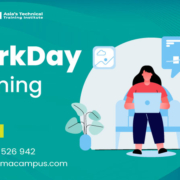How Workday Optimizes Your Payroll Integration to Ensure Accurate Paychecks?
Introduction:
When you have read enough surface-level content about payroll integrations, you stop looking for definitions. What you really want is what makes it work, what breaks it, and how you can make it better.
If you’re in a delivery-heavy tech city like Hyderabad, where deadlines are fast and errors are costly, you know payroll isn’t just about numbers-it’s about clean flows, real-time sync, and compliance at scale. That’s why more professionals here are investing in Workday HCM Certification just for career growth, but to design systems that don’t fail under load.
The need in 2025? A payroll pipeline that’s integrated end-to-end, with automation that makes corrections before the paycheck goes out.
What’s Really Powering the Accuracy?
Let’s break it down. Workday’s payroll integration isn’t built as an afterthought. It’s native, event-driven, and modular. That means every time an employee submits a timesheet, updates a bank account, or changes job roles-Workday already knows what needs to change in payroll.
Here’s where it gets interesting:
- It uses EIBs to move data from internal systems like Time Tracking.
- It uses Workday Studio when you need to customize flows-especially useful in India where compliance varies per state.
- Core Connectors handle vendor-side pushes-benefits, tax, GL, you name it.
- Workday Web Services (APIs) let external systems talk back in real time.
No delays. No data mismatches. That’s what ensures paycheck accuracy-even across thousands of employees. Now, let us see the technical flow in detail.
Technical Workflow in Action:
Here’s a simplified view of how the data flows during a payroll cycle using Workday:
| Stage | System | Tech Used | What Happens |
| Timesheet Entry | External Time App | EIB / Studio | Time-in/out pushed to Workday |
| Validation | Workday HCM | RaaS / Custom Reports | Check for errors (missing hours, tax info) |
| Gross-to-Net Calculation | Workday Payroll | Native Payroll Engine | Calculates earnings, deductions, taxes |
| GL Posting | Workday + ERP | Studio / EIB | Posts net pay and accounting entries |
| Payment & Reporting | Bank / Govt Agencies | WWS / Core Connector | Sends pay data, generates reports |
Everything here is rule-based and event-triggered, so errors don’t go downstream.
Hyderabad’s Edge in 2025:
In Hyderabad, you are not just seeing Workday adoption-you are seeing Workday customization. Firms are building mini tax engines using Studio. Some use RaaS to build Slack bots that show pre-payroll errors in real-time.
Workday HCM Training in Hyderabad is shifting from general training to role-based paths: one for integrators, one for compliance, and one for analytics.
The big shift? Teams are using AI-based validation on top of Workday’s logic-flagging anomalies like missing deductions or sudden salary spikes before they break payroll.
Common Payroll Breakpoints and How Workday Fixes Them?
Even in 2025, payroll breaks. Here’s where and how Workday patches the gaps:
| Issue | How Workday Handles It |
| Missed Tax Setup | Real-time validation checks before payroll is run |
| Time Entry Conflicts | Exception reports using RaaS + EIB to highlight problems |
| Wrong Compensation Plans | Job Change business process logic auto-updates pay rules |
| Stale Banking Info | Audit reports flag unverified bank details |
| Retroactive Pay Errors | Retro-pay engine recalculates based on effective dates |
This is what makes Workday more than just a payroll system. It’s a preemptive error correction engine.
Less Manual, More Configurable Logic:
In a modern payroll system, you don’t want ops teams clicking around. You want:
- Condition Rules: Triggers based on job changes, location moves, or salary shifts.
- Calculated Fields: To modify logic on the fly without breaking things.
- Security Domains: So only certain users touch certain data.
This is all possible using Workday’s Framework + Studio, and is why many are pursuing Workday Payroll Certification to build these with confidence. Now we will talk about why this matters in 2025.
Why Does This Matter More in 2025?
Payroll in 2025 isn’t about avoiding errors-it’s about catching them before they happen. With remote teams, cross-border taxation, and strict audit demands, real-time syncing isn’t optional.
Professionals in hubs like Hyderabad are pushing Workday beyond vanilla deployments-building smart integrations, using APIs for continuous sync, and reducing manual QA. If you have already read the beginner blogs, this is where you start building solutions, not reading about them.
So if you are already in this space, double down. Learn Studio. Explore calculated fields. Automate your audits.
That’s how you’ll own payroll in 2025.
Sum Up:
Workday’s payroll integration isn’t just accurate-it’s proactive. With EIBs, Studio, and real-time APIs, it’s built for modern workflows, not just legacy imports. For professionals who’ve already walked through the basics, the challenge now is creating automated, compliant, and scalable payroll systems that never miss a beat. In cities like Hyderabad, where Workday is not just adopted but optimized, this isn’t just possible-it’s happening. Whether you’re going deeper into Workday Payroll Certification or building your own connectors, Workday is your framework for future-ready payroll.








Leave a Reply
Want to join the discussion?Feel free to contribute!